Previously we described how to install a hangboard, even in tight spaces. In this article, we’ll expand these approaches to Campus boards. Campus training is important to the Rock Prodigy method, but it’s often the first training activity to be skipped because it requires unique equipment. This is unfortunate because; as described in the Rock Climber’s Training Manual, campus training develops several vital attributes for climbing:
• Muscle Fiber Recruitment
• Increased Muscle Fiber Contraction Speed
• Neuro-muscular coordination for dynamic movement
• Contact Strength (the ability to quickly generate force through your forearm muscles to “latch” a hold)
• Hand & Finger Accuracy
• Dynamic Aggression (or “go-for-it-ness”)
Therefore, Campus Training should be a part of your comprehensive training program.
Many climbing gyms have campus boards these days, but many of these seem more suited to show-and-tell rather than actual training. Just like with a hangboard, it is always preferable to build your own Campus Board so you can have complete control over the design and customize it to fit your needs. In this article comparing Campus Board configurations, we described the generally accepted standards for campus boards, but we’ll summarize them again here.
Campus Board Design
We recommend using Moon Half Spacing because it is much more common.
Regardless of the rungs, you’ll need a board to hang them from, and for most folks, this is the crux. Ideally, the board would have plenty of clearance all-around and would be infinitely tall, but practically, an effective training tool can be built in a much tighter space. Unlike a hangboard, a Campus Board needs to have some height to enable the dynamic movement, but, contrary to common belief, it doesn’t need to be extremely tall. As described in Chapter 7: Power of the Rock Climber’s Training Manual, the most essential campus exercise is a “Max Ladder,” which only requires a board a few feet long. (Consider that the ultimate standard for campus mastery is the “1-5-9” Max Ladder, which, with Moon Spacing requires a board only about 72 ” tall – most climbers will find a shorter board, around 48-55” tall, completely adequate for Max Ladder training).
Much of the height needed to install an effective campus board comes from the required starting height for the board. Ideally, you could hang the board high enough that the lowest rung would be about shoulder height, allowing you to start campusing from a standing athletic position (knees bent). This would require a mounting location about 10 feet tall for a 5’8” tall climber with a 60” tall board. Many folks won’t have a space that tall. Fortunately, it is possible (and many people prefer it) to perform campus exercises beginning from a sitting position (this is how I started campusing, probably because I didn’t know any better. The first board I ever trained on in the Sport Climbing Center in Colorado Springs in the late 90’s had a low-mounted campus board and that is how I learned). Campusing from the sitting or “pike” position is a little more demanding on your abs for the first move or two. It’s not ideal, but its far better than having a board with only 4 rungs. You can always start higher up the board when you don’t need the entire height of the board for a given set. Obviously, the benefit is that you can mount your board in a smaller space.
This video shows the second campus board I built. You can see the “pike” position I’m talking about:
I’ve found a good starting height for my body for a low-mount board is 40” off the floor. When I lived in Dayton, OH (see the video above), I had a garage that was 9’ 4” tall, and I mounted my board 40” off the floor, allowing for a board 76” tall, which is much taller than needed for Max Ladders, but allows some more height for warmup ladders, and longer campus sets (which are of dubious training value).
If your tallest space is only a standard eight foot ceiling, that still allows for a 58” tall board, which is enough space to do the “1-4-7” Max Ladder with Moon Spacing – a worthy goal and still a very difficult exercise.
Remember, because the board is mounted at an angle (15 degrees in this case), the board takes up less “room height” than the length of the board, according to this equation from high school trigonometry:
H=L cos(15°)
Therefore, if you want a little more Campus Board length, you could go with a steeper board, up to 20 degrees, and eek out a couple more inches (in an 8’ tall room, your board could be 59.5” “long” instead of 58” with a 20 degree overhang angle).
Be sure to provide some leg clearance behind the board, especially if you’ll be using the low/sitting mount – three feet is adequate, but you can get by with less in a pinch. Twelve inches should be considered the minimum.
Framing a Board
Once you’ve decided on your geometry, you’ll need to deal with the actual installation. A permanent installation, tied into the structure of your house, garage, etc. is ideal because it will consume the least amount of space and provide the most secure and stable platform for campusing. You don’t want to feel (or hear) your campus board flexing as you’re bounding from rung to rung.
The plywood should be a minimum of ¾” thick, and you should spring for the high-quality finish. It’s more expensive, but your fingers will thank you! The framing should be 2×6’s on 16” centers (meaning they are spaced 16” apart when measured from the centerline of each board to the centerline of the next). Start by mounting a base board flat against the wall at the desired height, as well as one on the ceiling. Next, mount joist hangers like these along the wall base board, and place your horizontal frames in the joist hangers. The angled frames can be attached to the ceiling base board with framing angles like these . Join the frames together at the base by either overlapping them, or using Tie Plates, like these. Finally, mount your plywood (with the finished side facing out), and install the rungs.
Free-Standing Campus Board
In many cases, a free-standing campus board may be required, especially if you live in an apartment, or your husband is dead-set against you disgracing his man-castle with an unsightly Campus Board. A collapsible, temporary Campus Board actually makes sense if you have limited space because you’ll only be using it for about 6-12 weeks out of the year (during your Power Phase of each training season), so it doesn’t need to clutter your life the rest of the time.
For our house in Florida, we built a free-standing, collapsible Campus Board stand because we were renting the house, and we weren’t allowed to make major modifications. We also envisioned taking it down went not in use, but we eventually decided to leave it up all the time because it wasn’t getting in the way (and we had better things to do 🙂 ). This design is overkill for most folks with its three sets of rungs, and 76” height. You could get away with a much smaller board that would be much more manageable. A single set of rungs is adequate for good campus training, and the board can be much shorter, as previously explained.

The collapsible Campus Board for our rental house in Florida. Note the pads – these are nice when your legs are flailing around.
The basic design concept is to use two A-frames that support the campusing surface. In reality, an asymmetric support frame is used because the vertical column holding the campusing surface carries the majority of the load. The entire stand is designed to break into 8 pieces which can all be assembled using 5/16″ bolts, so that only one size wrench is required. The nuts are T-nuts so that you don’t have to deal with securing hex nuts, which makes assembly and disassembly very easy.
The main support beams are constructed from two parallel 2×6’s separated by 2×6 spacers to increase the beam’s second moment of area (basically makes for a sturdier column). They are thus 4.5″ wide, 5.5″ deep, and about 10′ 9″ tall. These are quite sturdy! The beams break into two pieces for storage and these are connected by tongue-in-groove joints. This 3-wide spaced beam design also makes it possible to use very strong lap joints at the other connection points. The other leg of the “A” is a single 2×6 that fits into the space separating the two 2x6s forming the main beams. The cutouts in the 2×6’s are for aesthetics and weight savings; you can save a lot of time and effort by leaving the studs intact.
The campusing surface is broken into two pieces, the upper piece is 28″ tall, while the lower piece is 48″ tall. The plywood and rungs themselves are permanently fastened to vertical 2×4 studs, which are then permanently fastened to the horizontal beams (a 2×4 on the top, and a 2×6 on the bottom). The horizontal beams are fastened to the triangle supports with 5/16″ bolts. The horizontal seam between the two surfaces should be placed at the bottom of a row of rungs so that your fingers can’t drag across the seam accidentally. For Metolius spacing, this seam occurs conveniently at the bottom of rung 13. For Moon spacing, the seem should be just below the 12th rung (11 rungs-gaps X 4cm/gap/2.54 cm/inch = 47.64″). You’ll want to trim the lower board to 47.6″ so the 12th rung can be placed entirely on the upper board.
The final product turned out a little different than what is shown in the drawing, as we learned some things in the process and added some features. It takes about 30 minutes to set this up or tear it down.
This was designed with hinges at the base, so that the board could be easily assembled while lying flat, then hoisted into place and secured at the “toe” with one bolt each. On our first iteration, we assembled it this way in our living room, and it was very hard to lift due to the weight…two anorexic climbers could barely do it :).
After some modifications to lighten the structure, we also decided to erect it in a different room where we could leave it setup permanently, but this room is smaller, so we couldn’t assemble it flat and raise it. Instead, we assembled the triangle supports first, then attached the boards. Like I said before, this version is over-kill, so if you’re building from scratch, consider a shorter and narrower board (fewer sets of rungs). These next photos show the assembly process….
First, the main support beams are assembled:
Next, the main beams are lifted up. The base board (a single 2×6) is connected to the main beam with a sturdy door hinge, so it unfolds, remaining flat on the floor.
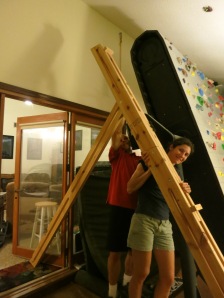
The secondary supports slide into the space in the main support beams and are fastened with a single 5/16″ bolt.
Once the A-frames are complete, the campusing surfaces can be attached. One of the modifications we made was to add little blocks on the rear of the main support beams to rest the horizontal beams on while they are being lifted into place and bolted down. In this photo, the upper surface is resting on these blocks while we reposition the ladders.
The horizontal beams are bolted down to the main support beams with 5/16″ bolts & T-nuts, once again, — two for each corner (8 total). Next, the lower, 48″ campusing surface is lifted into place and bolted down.
Finally, I used a framing angle to tie-in the top of the board to a ceiling rafter. This joint doesn’t carry any vertical load, but it resists horizontal (side-to-side) motion, and prevents the rig from swaying or jumping around as you campus up the board.
Portable Campus Board
If none of the aforementioned options are in the cards, consider this very low-profile design I built while deployed to Afghanistan:
It has a single row of rungs, so it’s only 16” wide, and 52” tall. I only had 11 rungs at my disposal, so I put gaps where rungs #2 and #8 would normally be, because I used these rungs the least. The entire board was designed to hang from a pullup bar, and it could be assembled and disassembled in a couple minutes. The bulk of the weight is supported by beefy steel hooks that hang over the pullup bar:
A lower cross brace is used to support the bottom of the board, maintaining the angle, and adding rigidity to the entire structure. This bottom brace was lashed to the pullup bar’s posts with speed cam-buckle straps. The board could be “assembled” in about 2 minutes, and the portable assembly weighed about 30 lbs, so it could be carried pretty easily from my “hooch.”
I had to compromise on the angle of the board, only overhanging it about 8 degrees to accommodate the geometry of the pullup bar and the materials I had, but this didn’t affect my training much. This rig worked surprisingly well. The biggest issue was that the entire structure (pullup bars and all) wobbled a bit with each move. This made campusing a bit more cruxy than usual, as I had to aim for slightly moving targets. Nevertheless, I performed 6 workouts on this board, and it helped me reach sufficient fitness to redpoint the very powerful and dynamic Scarface at Smith Rock within a month of my return from deployment.







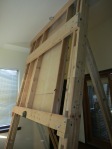
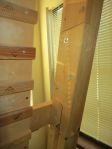


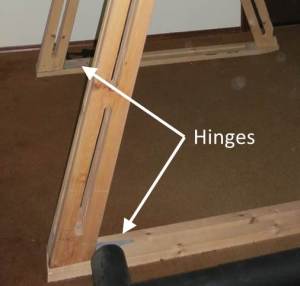








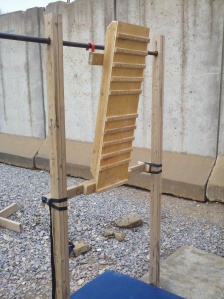
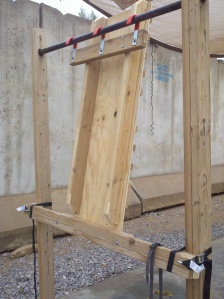


Pingback: How to Build a Campus Board – New Post on RCTM.com! | Lazy H Climbing Club
Mike, when you select your board’s location, how much space on either side of the board do you look for? I’ve never performed any campus training before and am not sure how much lateral swing would (or should) be involved. Imagine a campus board that is 4 feet wide placed in a 4 foot wide closet (height and depth are not an issue). Would you constantly be hitting the sides of the closet with your feet and/or body?
LikeLike
Chris, the short answer is yes, you will be hitting the walls in that scenario. If that is the best you can do, I suggest you place the larger (easier) rungs on the edges and the smallest rungs in the center of the board. When using the easier rungs, it’s easier to control your swing, and you’ll mostly be using those rungs for warming up.
You’ll notice that I had foam pads wrapped around the main support beams of my free standing campus board because I occasionally “dab”on them when using my smallest rungs.
I can’t say for sure what the side clearance should be, but I think you should shoot foot 18”.
LikeLike
Pingback: Home, Sweet Home! | The Rock Climber's Training Manual
Pingback: Taking Your Woody to the Next Level: Tips for Setting Up a Rad Home Wall | Crux Crush
Hey Mike,
How did you angle a 15 degree cut for the A-truss? Did you use a speed square or protractor?
I’m building a freestanding campus board. It will be 6′ x 4′ and will be 4′ off the ground. My ceiling is 10′. How long should the posts be to create the A-truss and how do I place them together?
At first I used MDF (not my choice), but eventually got plywood instead. I’ll take a picture of what my set up looks like if you don’t mind taking a look.
LikeLike
Paolo,
To make my cuts I just did some trigonometry and made measurements from there. You will have a right triangle with an “acute angle” of 15 degrees. For your situation, I would recommend making the “hypotenuse” 10 feet, therefore, it will overhang a distance of: Overhang = (10′)xSin(15degrees) = 2.6′ = 31 inches.
It’s vertical height will be: height = (10′)xCos(15degrees) = 9.7′ = 116 inches.
Just lay the pieces out in this configuration until you have the right lengths for the three sides of the triangle, and make your cuts from there. I used 5/16″ bolts to connect the pieces. Good luck, and let us know how it goes!
LikeLike
I have a miter saw. It has a 15 degree angle on it. If I cut the 2′ x 6′ at the 15 degree mark, will that translate to a 15 degree overhang?
LikeLike
I’m trying to track down a suitable “beefy steel hook” for a compact campus board of my own. I can’t find anything locally. Any suggestions on what to look for?
McMaster Carr item 1730A91 looks like a good bet, but I’m not sure if it is long enough compared to the pictures of the sample board. Any suggestions?
LikeLike
Andrew,
I got mine at Grainger, and I like them. Good luck!
http://m.grainger.com/mobile/product/APPROVED-VENDOR-Steel-Hook-4ERV7?cm_mmc=EMT-_-ShipConfirm-_-GcomShipConfirm-_-sku&cm_em=nolongerjak@gmail.com&RIID=89450874&SG=NULL&OAA=NULL&GID=
LikeLike
Pingback: Designing a Home Training Wall | The Rock Climber's Training Manual
Hi there,
I was wondering what your thoughts are on double spacing rungs with two separate sizes? I’d thought about putting the smaller rungs on a backing board so that they sat flush with the bigger ones. The bit of backing wood would finish at the bottom of the smaller rung so that it didn’t interfere with the larger rung below. Can you think of any particular problems with this arrangement or do you think it would work OK?
Thanks,
Sandy
LikeLike
Plenty of boards are set up that way. I don’t really like it for campusing at your limit because sooner or later you will need that half-rung to help you progress to the next-hardest movement. However, it can be a good way to save space on warmup terrain. For example, my board has two columns of rungs. The right column is strictly small rungs, set at Moon half-spacing (11cm on center). The left column is “interlaced” with Medium rungs incut-side-up and small rungs flat-side-up. I use the left column to warm up, but once I’m trying hard, I used the right column exclusively.
LikeLike
I like the campus board that you had in Dayton attached to the garage. I am looking to build one just like that for my 13 year old daughter in our basement. She is not tall, only 5’1″ tall. And the ceiling height is 8’10” (106″) not 112″ unfortunately. So my question is two-fold: 1) I have 2 x 4s already installed in the space I intend to use, not 2 x 6s. Do you think that will be sufficient? 2) Do you think I can use your plan as is and have her start only 34″ off the ground (instead of 40″ as you had yours)? She is not as tall as you of course. 2) Are more detailed plans available for that exact design so I can just duplicate what you did in your garage?
LikeLike
Scott, besides writing the Rock Climber’s Training Manual, I’m also a youth climbibg coach. I strongly discourage kids in the puberty age range from campusing because of the high occurrence of Growth Plate injuries at those ages. While no definitive research has been done, several articles have been written that agree with me based on a lot of anecdotal evidence. Best to stick to limit bouldering for now. Good luck, and happy training! Mike
LikeLike
I am trying to find a contractor to build a free standing or attached to wall angled campus board for our basement in Lancaster, PA. Do you know of anyone?
LikeLike
I got nothin, but if you post to our forum, I know there is at least one regular contributor who lives in PA and may be able to help.
LikeLike
How much advantage is it to buying the pre-made metolius rungs ( or other brand) as opposed to just making your own. I’m trying to save money, but I’m also not much of a carpenter
LikeLike
I think the best reason to use Metolius rungs is consistency. If you want to compare your campus performance with others, it’s best if everyone is using the same stuff. Different wood types and rung shapes can make it easier or harder to latch the rungs. The other reason to use professionally made rungs is if your woodworking skills are marginal. You’re going to be slamming your precious finger skin against these things so you want them to be smooth, evenly shaped and strong.
That said, I’ve used some homemade rungs that were as good or better than the Metolius rungs (made by Lee Brinkerhoff). So it’s certainly possible to do with the right equipment. Table saw and table router and good woodworking skills are really helpful.
Mark
LikeLike
Pingback: Battle of the Boards: Moon, Hang and Campus – No Limits Climbing
When you talk about the starting height of 40” off the floor, does it means you build your board starting 40” from the mattress or from the floor? our mattress is gonna be fat and covering all the floor so that could make a big difference. Thanks a lot
LikeLike
The bottom line is to build the board so there is enough room for you to pull yourself off the ground. So if you plan to have the pad under you when you’re starting, I would factor that thickness into your calculations.
LikeLike
Pingback: How To Build A Campus Board | Information
Mike – when you were in Afghanistan with the campus board – what did your colleagues think? Did anyone try and get on it and get shut down?
LikeLike
Pingback: Der Ultimative Guide: 10x mehr Kraft beim Klettertraining - enziano Blog
Pingback: Land der begrenzten Möglichkeiten: das Klettertraining zuhause | Bergfreunde
Pingback: Tips For Setting Up A Rad Home Wall: Taking Your Woody To The Next Level - Crux Crush